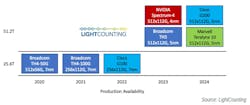InfiniBand continues to be challenged by Ethernet. While InfiniBand was the dominant back-end network technology for AI clusters, a new LightCounting report revealed that Ethernet is now winning high-profile designs.
One of the notable developments was xAI’s recent move to leverage Nvidia's Spectrum-X Ethernet networking platform for its 100,000-GPU supercomputer versus InfiniBand.
During the first half of this year, Nvidia's networking revenue–including both InfiniBand and Ethernet–grew thrice over last year. LightCounting said NVIDIA is “currently in a unique position to offer full-stack solutions (hardware and software) for customers entering the AI race.”
Data center moves
Another key trend to watch is the actions of the “mega” data center operators. These providers deploy AI front-end and back-end fabrics based on other vendors' Ethernet switch ASICs.
Besides working with NVIDIA, Broadcom, Cisco, and Marvell, 51.2 Tbps ASICs are also shipped.
“Although four vendors may appear too many, Cisco and Nvidia principally ship their respective ASICs in system-level products, whereas Broadcom and Marvell are pure merchant-chip vendors,” LightCounting said in its report.
Optical transceiver growth
To better correlate with its optical transceiver forecast, the research firm revised its model and increased its forecast for 800 G transceivers. LightCounting said that these changes prompted it to revise its forecast of 51.2T switch chips, growing to more than $2 billion even as 102T chips began to ramp. At the same time, it forecasts for optical circuit switches (OCS) to reflect deployment interest from a broader set of leading cloud companies.
LightCounting’s forecast also includes shipment projections for SerDes lanes by speed from 50G to 200G PAM4. It also forecasts co-packaged optics (CPO) adoption, including switch densities up to 204T.
“While massive investments in AI infrastructure are driving overall network-system growth, not all technologies will benefit equally,” LightCounting said. “Our new report explains the dynamics of network switching, driven by our underlying models for hyperscale operators.”
For related articles, visit the Business Topic Center.
For more information on high-speed transmission systems and suppliers, visit the Lightwave Buyer’s Guide.
To stay abreast of fiber network deployments, subscribe to Lightwave’s Service Providers and Datacom/Data Center newsletters.
About the Author
Sean Buckley
Sean is responsible for establishing and executing the editorial strategy of Lightwave across its website, email newsletters, events, and other information products.


